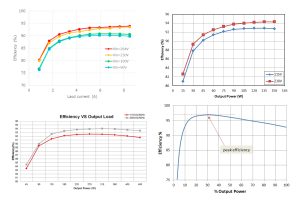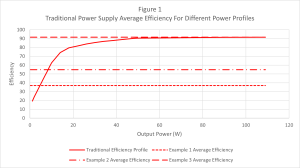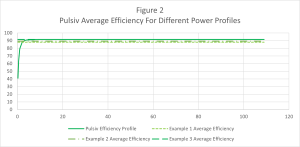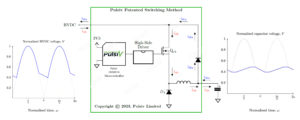
Introduction
In order to comply with tightening regulations aimed at reducing energy consumption and achieving “Net Zero” targets, the global electronics industry must embrace new and innovative methods of designing efficient products that are also economical to manufacture. While GaN and SiC technologies have become a popular choice for enhancing peak efficiency, they have a limited impact during low-power modes where devices tend to operate for most of the time. With a growing number of smart devices constantly connected to the internet during standby, poor efficiency at low power represents a significant source of waste.
In this article, we analyse some typical power supply efficiency profiles, how they influence overall efficiency in different usage scenarios and explore an entirely new approach from Pulsiv that can deliver significant improvements without adding cost.
Why are traditional power supply designs inefficient at low power?
Common methods of converting AC to DC involve combining a Boost PFC design and a Flyback or LLC topology. Multiple variations and combinations are available to deliver high power factor and maximise peak efficiency, but they share a similar performance profile that compromises efficiency more dramatically as the load is reduced.

In these graphs (published for commercially available power supply designs), the trend is clear:
- Performance at low load conditions is noticeably reduced as a direct result of losses in the series inductor used for power factor correction
- Maximum efficiency is not usually achieved until full load
- No data is reported below 10 – 20% of the load because the numbers are usually unimpressive
- The efficiency at 115V is lower than at 230V, but the profile is similar
How load conditions impact average efficiency
The electricity consumption of a product will often vary depending on its typical operation and intended purpose, with most spending only a small percentage of the time running at full power. A significant number of devices remain in standby mode and all internet connected products continue to perform necessary background tasks such as monitoring or updates even when not in use.
Kitchen appliances for example, are typically used for relatively short periods of time and remain in standby mode for quick access. In contrast, smart TV’s, games consoles, printers, & security cameras provide continuous intelligent monitoring & remote-control features for consumer convenience.
Certain industrial products such as Air Conditioning Units, Factory Equipment and Motor Drives may have simple on/off control, operate at maximum power when being used, or benefit from manual adjustment.
Figure 1 demonstrates the average efficiency of a product using traditional power supply technology, depending on how it behaves during normal operation:

Assuming peak efficiency is 91%, standby mode = 2% load, low power mode = 25% load and full power = 100% of the maximum output:
Example 1 shows an average efficiency of just 37% when 80% of time is spent in standby-mode, 10% in low-power mode and 10% at full power.
Example 2 shows an average efficiency of just 55% when 50% of time is spent in standby-mode, 40% in low-power mode and 10% at full power
Example 3 shows an average efficiency of 91% when 100% of time is spent at full power.
While the peak efficiency of a traditional power supply may look impressive, this demonstrates the importance of understanding typical usage and the impact on overall average efficiency.
The effect of Pulsiv OSMIUM technology
Pulsiv has designed, developed, and patented a new front-end AC to DC power conversion method that delivers:
- High flat efficiency with 97.5% average, 99.5% peak and 90% at just 2W
- 96% power factor
- Universal mains input voltage
- No inrush current

Assuming peak efficiency is 91%, standby mode = 2% load, low power mode = 25% load and full power = 100% of the maximum output:
Figure 2 demonstrates a significant improvement in average efficiency when using Pulsiv OSMIUM technology paired with a quasi-resonant flyback. Under the same conditions:
Example 1 shows an average efficiency of 88% compared to the previous 37%
Example 2 shows an average efficiency of 89% compared to the previous 56%
Example 3 shows the same average efficiency of 91% without the complexity of using an LLC.
Many governing bodies such as The European Commission and US Department of Energy (D.O.E), are constantly driving manufacturers to improve efficiency and reduce energy consumption by setting minimum standards for different applications. As a result, they face an ongoing design challenge which often means adding complexity, time, and cost. Engineers can now combine Pulsiv OSMIUM technology with commodity flybacks to replace conventional LLC designs, simplifying the design process while reducing cost.
What is Pulsiv OSMIUM technology?
Pulsiv OSMIUM technology uses patented switching techniques to improve efficiency at low loads and therefore increase average efficiency. Significant energy waste reduction is achieved by charging current into a parallel capacitor which replaces a lossy boost PFC inductor. The Pulsiv OSMIUM microcontroller manages the entire conversion process to ensure that just enough energy is available to ride through a period when the grid cannot support the load. The capacitor is then discharged by a follow-on DC to DC converter through a simple diode. The voltage on the storage capacitor is regulated to 150V or 180V (pin selectable), which means avoiding conventional 400V capacitors which are larger and more expensive.

Pulsiv CEO Darrel Kingham adds: “Companies can continue to market peak efficiency, but understanding average efficiency is actually more important in most real-world applications. Any OEM motivated to reduce energy waste or manufacturing costs can benefit from using Pulsiv OSMIUM technology to meet the most demanding energy standards. Our flat efficiency profile is truly unique, and customers can achieve higher performance numbers by combining the Pulsiv OSMIUM front-end with a suitable GaN optimised DC-DC converter”
About Pulsiv
Founded in 2013 as a spin out from the University of Plymouth (UK), the company has developed and patented technology to significantly improve efficiency and reduce the energy wasted in power electronics designs used in virtually any mains powered or battery charging application. Pulsiv is committed to helping the world transition to renewable energy and reducing the impact that electronic devices have on the environment.
Useful links:
What is Pulsiv OSMIUM technology click here
Pulsiv OSMIUM microcontrollers click here
Pulsiv reference designs click here
Pulsiv evaluation boards click here
Contact Pulsiv click here